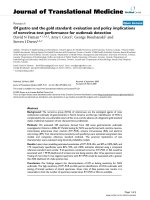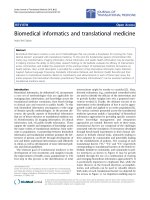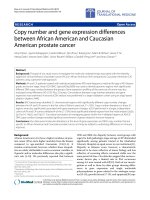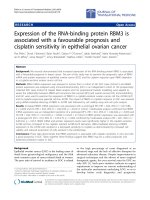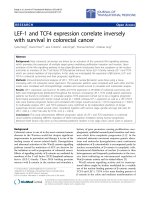báo cáo hóa học: " Respiratory distress and chest pain: a perforated peptic ulcer with an unusual presentation" pdf
Bạn đang xem bản rút gọn của tài liệu. Xem và tải ngay bản đầy đủ của tài liệu tại đây (678.6 KB, 5 trang )
CAS E REP O R T Open Access
Respiratory distress and chest pain: a perforated
peptic ulcer with an unusual presentation
David I Bruner
1,2*
and Corey Gustafson
2
Abstract
Background: Dyspnea and chest pain are common presenting complaints to the ED, and cou pled together can
present a challenging diagnostic dilemma in patients in extremis. A thoughtful evaluation is required, giving due
diligence to the immediate life threats as well as multiple etiologies which can cause serious morbidity. A
perforated peptic ulcer is one such possibility and requires rapid diagnosis and prompt intervention to avo id the
associated high risk of morbidity and mortality.
Method: We present a case report of a 54 year old man with respiratory distress and chest pain as the initial
Emergency Department presentation of a perforated duodenal ulcer.
Results: We discuss an unusua l presentation of a perforated duodenal ulcer that was recognized in the emergency
department and treated promptly. The patient was surgically treated immediately, had a prolonged and
complicated post-operative course, but is ultimately doing well. We also provide a brief literature review of the risk
factors, imaging choices, and management decision required to treat a perforated ulcer.
Conclusions: Perforated ulcers can have highly varied presentations and are occasionally difficult to diagnose in a
complicated patient. Knowledge of the risk factors and a thorough history and physical can point to the diagnosis,
but timely and appropriate imaging is often required because delays in diagnosis and treatment lead to poor
outcomes. Early administration of antibiotics and immediate surgical repair are necessary to limit morbidity and
mortality.
Introduction
Dyspnea and chest pain are common presenting com-
plaints to the Emergency Department (ED), and they
often occur concurrently. This combination of symp-
toms presents a diagnostic challengeforanyphysician
given the broad differential each complaint entails. A
thoughtful and judicious workup is required, and avoid-
ance of anchoring on a particular diagnosis is nece ssary
to avoid missing alternative, equally life-threatening pos-
sibilities.Wepresentthecaseofapatientwithperfo-
rated duodenal ulcer who initially arrived with
respiratory distress and hypoxia.
Case presentation
A 54-year-old white male presented to the Emergency
Department with complaints of progressive dyspnea and
chest pain that had started simultaneously with acute
onset 10 h before arrival. He stated the chest pain
startedwhilegoingfromaseated to standing position.
The pain was substernal and sharp with epigastric radia-
tion initally. The pain was also noted to be worse with
movement, and although it was still present, it had sub-
sequently waned since the initial symptom onset. His
dyspnea started immediately after the onset of chest
pain and was worse with exertion. At presentation, he
had progressed to the point of breathlessness, prompting
his ED visit. Review of systems revea led no nausea,
vomiting, diarrhea, fevers, or recent cough or conges-
tion, as well as no s imilar episodes of pain or history of
coronary artery disease, heart failure, chronic obstructive
pulmonary disease, gastro-esophageal reflux disease, or
GI bleeding episodes.
His past medical history was significant for osteoar-
thritis and benign prost atic hypertrophy, and he denied
any prior surgery. His medications included ibuprofen
(800 mg three times a day with meals), which he has
taken routinely over the past month. Of note, he had
* Correspondence:
1
Uniformed Services University of the Health Sciences, Bethesda, MD, USA
Full list of author information is available at the end of the article
Bruner and Gustafson International Journal of Emergency Medicine 2011, 4:34
/>© 2011 Bruner and Gustafson; licensee Springer. This is an Open Access article distributed under the terms of the Creative Co mmons
Attribu tion License (http://creativecomm ons.org/licenses/by/2.0), which permits unrestricted use, distribution, and reprodu ction in
any medium, provided the original work is properly cited.
smoked a pack of cigarettes per day for the past 40
years and claimed only occasional alcohol usage.
Physical examination revealed an obese, ashen co lored
male in obvious respiratory distress. Vital signs were
temperature of 36.4°C (97.5°F), heart rate 118, respira-
tory rate 36, oxygen saturation 77% on room air, and
blood pressure 151/88 mmHg. The pat ient was alert,
oriented and in obvious discomfo rt. His cardiovascular
examin ation was remarkable for tachycardia, with regu-
lar and strong distal pulses in all four extremities. Pul-
monary evaluation demonstrated clear breath sounds in
the upper and lower lung fields, with diminished volume
in the bases. His abdomen was soft and mildly distended
with slight but diffuse tenderness to soft touch and per-
cussion without tympany or guarding. Stool was positive
for occult blood. A bedside abdominal ultrasound was
performed and was negative for free fluid or abdominal
aortic aneurysm. The ultrasound was difficult to per-
form because the patient became increasingly d yspneic
and anxious while laying supine and was unable to lay
still. His skin was ashen and diaphoretic without pete-
chiae, purpura, or stigmata of liver disease.
Initial diagnostics ordere d included an electrocardio-
gram revealing sinus tachycardia and no ischemic
changes, and an upright portable chest x-ray (see
Figure 1) that was unremarkable for acute cardiopul-
monary processes or free air in the abdomen. Labora-
tory analysis showed an elevated i-stat troponin-I of
0.74 ng/ml (normal <0.034 ng/ml), D-dimer was 5.73
mcg/ml (normal <0.48 mcg/ml), and a white blood cell
count of 18.8 (× 1,000/ul) with a left shift. Electrolytes,
renal function, and coagulation studies were normal,
and his lactate was 1.4 mmol/l (normal <2.2 mmol/l).
He was immediately started on oxygen using a non-
rebreather with immediate improvement in h is dyspnea
and oxygen saturation. His pain was addressed using
morphine. Given his positive troponin, 162 mg o f
aspirin was given; heparin was withheld because the
patient was guaiac positive. Shortly after his improved
chest pain and respiratory distress, the patient stated
that the abdominal pain was more prominent.
Cardiology consultation was considered because of the
troponin elevation, but because of the increased abdom-
inal pain, a non-contrasted CT of the abdomen (see Fig-
ure 2) was obtained, which revealed free air in the
abdomen and a perforated duodenal ulcer.
Intravenous fluid resusci tation, antibiotics, and pro-
ton-pump inhibitor therapy were ordered, and surgery
was consulted. He was taken to the operating room for
definitive treatment with an omental patch procedure.
His hospital stay was long and complicated by an
ischemic stroke, but he was eventually discharged to a
rehabilitation facility andisexpectedtohaveafunc-
tional recovery.
Discussion
Acut e bowel perforations are potentially life-threatenin g
events that must be recognized immediately i n order to
begin prompt treatment and surgical intervention
because of the high risk of morbidity and mortality if
not recognized in a timely manner. This case is unique
because there has been only one r eported duodenal
ulcer perforation patient to present with hypoxia and
dyspnea as initial symptoms [1]. This discussion focuses
Figure 1 Upright portable chest X-ray. No acute cardiopulmonary
process was noted and no intra-abdominal free air.
Figure 2 Non-contrast CT of abdomen revealing intra-
abdominal free air and perforated viscus.
Bruner and Gustafson International Journal of Emergency Medicine 2011, 4:34
/>Page 2 of 5
primarily on the diagnosis and ED management of pep-
tic and duodenal ulcer perforations.
Epidemiology and risk factors
Perforated duodenal ulcers typically occur in patients
with known peptic ulcer disease (PUD). PUD in the
United States is most commonly due to Helicobacter
pylori (H. pylori) or non-steroidal anti-in flammatory
drug (NSAID) use. The estimated rate of perforation
or bleeding in patients with known peptic ulcer dis-
ease is 1-2% per year. Duodenal ulcers are associated
with 60% of perforations due to peptic ulcer disease.
In contrast, antral and gastric body ulcers each
account for 20% of perforated ulcers. NSAID use is
associated with up to one-half of perforated ulcers
[2,3]. Smoking, age over 65, and a history of compli-
cated ulcer disease are also associated with a higher
risk of ulcer perforation.
Our patient’s only risk factor for a duodenal ulcer was
his frequent use of NSAIDs for his arthritis. According to
the Food and Drug Administration, NSAIDs are associated
with a 1-4% r isk per year of significant gastrointestinal
events, accounting for 3,000 deaths per year, and the risk
of complications is related to the daily dose of NSAIDs
ingested [4]. NSAIDs have excellent utility in providing
analgesia for a variety of conditions, but they are known to
cause injury to the gastric and duodenal mucosa, leading
to ulcer formation, bleeding, and possible p erforation.
These medications are taken daily in the US b y approxi-
mately 3 million people, and approximately 10% of people
on daily NSAIDs will have an acute ulcer [4].
NSAIDsaremorelikelytoproducegastriculcers
rather than duodenal ulcers, but they are known to
cause duodenal ulcers as well. Lanas et al. demonstrated
that the use of NSAIDs increased the risk of bleeding
from a p eptic ulcer with an odds ratio of 7.4 [5]. Smed-
ley and colleagues, however, showed that NSAID use
was only associated with 12% of duodenal ulcer perfora-
tions and 13% of duodenal ulcer bleeding. They also
reported several older studies with similar results [6].
Helicoba cter pylori has been shown to be the cause of
duodenal ulcers in up to 61% of patients [7]. H. pylori is
the most common known cause of peptic and duodenal
ulcer disease. It is estimated that up to 90% of duodenal
ulcers and 75% of gastric ulcers are due to H. pylori
infection [4]. The incidence of H. pylori appears to be
decreasing in frequency in developed nations because of
changes in diet, increased use o f proton-pump inhibi-
tors, and improved personal hygiene over the last few
decades, but it remains a s ignificant cause of PUD in
the older population [8]. The association between H.
pylori and perforation is unclear, however, with some
studies finding a significant relationship and others sug-
gesting minimal to no association, which suggests that
chronic ulcer disease has a different pathophysiology
from acute duodenal ulcer perforation [9,10].
Clinical presentation
The history of present i llness in patients with perforated
ulcers frequently reflects a history of PUD, but many
patients will deny the diagnosis of PUD despite a prior
history of indigestion symptoms. Typically, initial symp-
toms begin with an onset of severe abdominal pain that
is commonly epigastric in location, but becomes gener-
alized as a chemical peritonitis ensues. This is often
associated with vomiting, diaphoresis, and an ashen
appearance in early stages. Temperatures may frequently
be subnormal [11]. The pain may begin to subside
within several hours, leading some to suspect they are
improving.
Cope’ s textbook of surgery reports three phases of
presentation fo r perforated ulcers [11]. Phase one con-
sists of the pain as noted above, which is when most
patients will present to care because of the severity of
pain. Phase two occurs between 2 and 12 h from symp-
tom onset, and pain will often improve during this time.
However, the patient will most likely have a persistently
rigid abdomen, pain with movement, spreading of pain
to include the lower q uadrants as fluid and air fill the
abdomen, and shallow respirations. Phase three (12 h
and beyond) is associated with abdominal distention,
generalized peritonitis, and hemodynamic collapse,
which occurs in approximately 5-10% of patients, most
often in those between the ages of 40 and 60 years old
[12]. Early recognition of this disease is essential because
the overall prognosis is goo d if managed within the first
6 h of perforation, whereas mortality is much higher if
there is a delay in diagnosis or presentation of g reater
than 12 h [11,13].
Our patient most likely presented during phase two of
this disease process as his pain had improved, but he
was having respiratory distress, which may have over-
taxed his myocardium causing a troponin leak. It is also
possible that our patient’s respiratory distress may have
been secondar y to myocar dial dysfunction . We believed
that his troponin elev atio n, myocardial dysfunction, and
subsequent respiratory symptoms were likely secondary
to the overall systemic inflammatory response resulting
from the perforated ulcer, thus increasing myocardial
oxygen demand to a level that his heart could not
match.
Diagnostic imaging
Imaging choices for diagnosing bowel perforations
include plain films and computed tomography. An
upright chest x- ray is an excellent first cho ice. A po si-
tive upright chest x-ray (free air beneath the diaphragm)
can acutely make the diagnosis , but plain films can miss
Bruner and Gustafson International Journal of Emergency Medicine 2011, 4:34
/>Page 3 of 5
15% to 30% of patients with free air in the abdomen
accord ing to surgical texts [4,11]. Some authors suggest
insufflation of 200 to 300 ml of air via a nasogastric
tube to increase the yield of plain films, but they offer
no data as to how much this may help [14]. Specifically
for duodenal ulcers, 10-20% of patients will not have
free air on plain films.
If a CT is performed with contrast, one should use
water-soluble gastrograffin contrast. A leak of contrast
confirms the diagnosis. Small studies have e xamined
this and suggested that CT is 100% sensitive in the diag-
nosis of pneumoperitoneum, whereas upright chest film
was only 33% sensitive for small pockets of air [15]. No
studies have compared contras t versus non-contrast CT
for this disease, but both are capable of making an accu-
rate diagnosis [10,11,16]. In a small minority of patients
with perforated duodenal ulcers, there will be no free
air, and only free fluid will be present on CT [16].
A non-contrast CT scan was obtained in our patient
for the sake of expediency as we did not feel a 2-h delay
(the standard requirement for contrast CT scans at our
institution) would be appropriate for a patient with a
potentially perforated ulcer with significant tachycardia
and hypoxia. Because we were also considering acute
myocardial infarction as the cause of his symptoms, we
did not want to delay appropriate cardiology consulta-
tion and treatment if no intra-abdominal pathology
were found.
Management and prognosis
Acute management of these patients in the emergency
department involves several different steps, but most
importantly, the diagnosis must be made quickly, and
general surgeons should be involved immediately upon
making the diagnosis of a perforated ulcer.
There are no exact recommendations for pain control,
but adequate pain control with opioid medications
should be initiated promptly with consideration for the
patient’s hemodynamic status. There are multiple stu-
dies showing that opioid medications do not mask peri-
tonitis in other surgical cases such as appendicitis and
cholecystitis, and it seems unlikely that pain control will
mask the peritonitis of a bowel perforation [17-20].
Initiation of treatment to reduce acid secretion with
proton pump inhibitors should also be started to try to
decrease spillage of acidic fluid into the abdomen. Also,
broad spectrum antibiotics should be started upon
recognition of a bowel perforation. Antibiotic choices
include piperacillin/tazobactam, cefotaxime, amoxicillin,
or a f louroquinolone plus metronidazole. There should
be no delay in the administration o f antibiotics. Studies
have suggested that up to 13% of patients receive inap-
propriate initial antibiotics, which may lead to a worse
prognosis [13,21].
Emergent surgical consultation is required fo r opera-
tive repair of the site of bowel perforation. Clearly, the
source of the perf oration will determine t he type and
extent of surgery, but the majority of these are managed
with an omental patch closure with or without a parietal
cell or truncal vagotomy.
Conclusion
Our patient’ s presentation was particularly unusual
because the presenting signs and symptoms were those of
chest pain and respiratory distress. As those symptoms
improved, the patient subsequently had acute worsening of
abdominal pain prompting the CT scan that yielded the
diagnosis of a perforated duodenal ulcer. Considering the
patient had significant abdominal girth, his pain seemed
minimal on exam, and the acute peritonitis and free air in
the peritoneal cavity may have irritated a nd e levated his
diaphragm enough t o cause chest pain, short ness o f breath,
and hypoxia. He also had an elevated troponin, suggesting
that the stress of his bowel perforation and systemic illness
taxed his myocardium, causing the troponin leak and sub-
sequent decrea sed cardia c output resulting in hy poxia.
Consent
Written informed consent was obtained from the patient
for publicatio n of this case report and any accompany-
ing images. A copy of the writ ten consent is available
for review by the Editor-in-Chief of this journal.
Abbreviations
ED: emergency department; CT: computed tomography; NSAID: non-
steroidal anti-inflammatory drug; PUD: peptic ulcer disease.
Acknowledgements
We would like to thank the Naval Medical Center Library Staff for their
assistance with a thorough literature search and review of this topic. The
authors were, otherwise, the sole designers, authors, and contributors to this
manuscript. We received no funding for this article.
Author details
1
Uniformed Services University of the Health Sciences, Bethesda, MD, USA
2
Emergency Department, Naval Medical Center Portsmouth, Portsmouth, VA,
USA
Authors’ contributions
DB conceived the idea for this case report, performed the literature review,
wrote the case discussion, and provide d formatting for the article. CG
assisted with the literature review and wrote the case report section of this
manuscript. All authors read and approved the final manuscript.
Competing interests
The authors declare that they have no competing interests.
Received: 16 December 2010 Accepted: 22 June 2011
Published: 22 June 2011
References
1. Assnar AN, Sinclair CL, Shrestha DB: “Dyspnoea and chest pain presenting
as a perforated duodenal ulcer,”. British Journal of Hospital Medicine 2009,
70(10):599.
Bruner and Gustafson International Journal of Emergency Medicine 2011, 4:34
/>Page 4 of 5
2. Gunshefski L, Flancbaum L, Brolin RE, Frankel A: “Changing patters in
perforated peptic ulcer disease,”. Am Surg 1990, 56(4):270-4.
3. Lanas A, Serrano P, Bajador E, Esteva F, Benito R, Sainz R: “Evidence of
aspirin use in both upper and lower gastrointestinal perforation,”.
Gastroenterology 1997, 112(3):683-9.
4. Mercer DW, Robinson EK: Stomach. In Townsend: Sabiston Textbook of
Surgery. Volume Chap. 47 18 edition. Philadelphia, PA. Saunders Elsevier;
2007.
5. Lanas A, Bajador E, Serrano P, Fuentes J, Carreno S, Guardia J, Sanz M,
Montero M, Sainz R: “Nitrovasodilators, low-dose aspirin, other
nonsteroidal antiinflammatory drugs, and the risk of upper
gastrointestinal bleeding,”. New England Journal of Medicine 2000,
343:834-9.
6. Smedley FH, Taube M, Leach R, Wastell C: “Non-steroidal anti-
inflammatory drug ingestion: retrospective study of 272 bleeding or
perforated ulcers,”. Postgraduate Medical Journal 1989, 65:892-5.
7. Jyotheeswaran S, Shah AN, Hin HO, Potter GD, Ona FV, Chey WY:
“Prevalence of Helicobacter pylori in peptic ulcer patients in greater
Rochester, NY: Is empirical triple therapy justified?”. American Journal of
Gastroenterology 1998, 93(4):574-8.
8. Suerbaum S, Michetti P: “Helicobacter pylori infection,”. New England
Journal of Medicine 2002, 347(15):1175-86.
9. Kate V, Ananthakrishnan N, Badrinath S: “Effect of Helicobacter pylori
eradiation on the ulcer recurrence rate after simple closure of
perforated duodenal ulcer: retrospective and prospective randomized
controlled studies,”. British Journal of Surgery 2001, 8(88):1054-8.
10. Reinbach DH, Cruickshank G, McColl KE: “Acute perforated duodenal ulcer
is not associated with Helicobacter pylori infection,”. Gut 1993,
34(10):1344-7.
11. Silen W: “Perforation of a Gastric or Duodenal Ulcer”. Cope’s Early
Diagnosis of the Acute Abdomen.
21 edition. New York NY: Oxford University
Press; 2005.
12. Lagoo S, McMahon RL, Kakihara M, Pappas TN, Eubanks S: “The sixth
decision regarding perforated duodenal ulcer,”. Journal of the Society of
Laparoendoscopic Surgeons 2002, 6:359-368.
13. Krobot K, Yin D, Zhang Q, Sen S, Altendorf-Hofmann A, Scheele J, Sendt W:
“Effect of inappropriate initial empiric antibiotic therapy on the outcome
of patient with community-acquired intra-abdominal infections requiring
surgery,”. Eur J Microbiol Infect Dis 2004, 23(9):682-7.
14. Young GP: “Abdominal catastrophes,”. Emergency Medicine Clinics of North
America 1989, 7(3):699-720.
15. Stapakis JC, Thickman D: “Diagnosis of pneumoperitoneum: abdominal
CT vs. upright chest film,”. J Comput Assist Tomogr 1992, 16(5):713-6.
16. Grassi R, Roman S, Pinto A, Romano L: “Gastro-duodenal perforations:
conventional plain film, US and CT findings in 166 consecutive
patients,”. European Journal of Radiology 2004, 50(1):30-6.
17. Thomas SH, Silen W, Cheema F, Reisner A, Aman S, Goldstein JN,
Kumar AM, Stair TO: “Effects of morphine analgesia on diagnostic
accuracy in emergency department patients with abdominal pain: a
prospective, randomized trial,”. Journal of the American College of Surgery
2003, 196:18-31.
18. Gallagher EJ, Esses D, Lee C, Lahn M, Bijur PE: “Randomized clinical trial of
morphine in acute abdominal pain,”. Annals of Emergency Medicine 2006,
48:150-160.
19. Manterola C, Astudillo P, Losada H, Pineda V, Sanhueza A, Vial M:
“Analgesia in patient with acute abdominal pain,”. Cocharane Database
Syst Rev 2007, , 3: CD005660.
20. Ranji SR, Goldman LE, Simel DL, Shojania KG: “Do opiates affect the clinical
evaluation of patients with acute abdominal pain?”. JAMA 2006,
296(14):1764-74.
21. Crofts TJ, Park KG, Steele RJ, Chung SS, Li AK: “A randomized trial of
nonoperative treatment of perforated peptic ulcer,”.
New England Journal
of Medicine 1989, 320(15):970-3.
doi:10.1186/1865-1380-4-34
Cite this article as: Bruner and Gustafson: Respiratory distress and chest
pain: a perforated peptic ulcer with an unusual presentation.
International Journal of Emergency Medicine 2011 4:34.
Submit your manuscript to a
journal and benefi t from:
7 Convenient online submission
7 Rigorous peer review
7 Immediate publication on acceptance
7 Open access: articles freely available online
7 High visibility within the fi eld
7 Retaining the copyright to your article
Submit your next manuscript at 7 springeropen.com
Bruner and Gustafson International Journal of Emergency Medicine 2011, 4:34
/>Page 5 of 5


